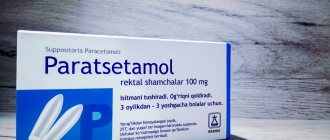Norms and rules for measuring body temperature during pregnancy
Varieties of methods for measuring body temperature:
- Axillary temperature. Measured in the dry armpit for 10 minutes. The norm for an adult is in the range of 35.5–37.0 degrees Celsius. During pregnancy, the upper limit of normal can reach 37.5 degrees Celsius; if your general well-being is not affected, there is no reason to worry about this.
- Oral temperature. Measured in the oral cavity for 5 minutes. The norm for an adult is 0.2–0.5 degrees Celsius higher than that for axillary temperature.
- Rectal temperature. Measured in the rectum for 5 minutes. The norm with this measurement method is 0.5-0.6 degrees Celsius higher than the norm for axillary temperature.
- Tympanic temperature. It is measured with a special thermometer in the ear canal. The normal indicators for this measurement correspond to the rectal temperature indicators.
In the CIS countries, the method of measuring body temperature in the armpit dominates over the others. Therefore, further we will talk specifically about axillary temperature.
Low temperature in pregnant women
The opposite situation is also possible, when women stably maintain values below 36.6°C, and in some cases fall below 36.0°C. The reasons are varied:
We suggest you read: How many laser hair removal sessions are needed?
- individual characteristics;
- toxicosis;
- fatigue;
- Iron-deficiency anemia;
- deficiency of nutritional components;
- endocrine disorders.
It is important to understand not only the reasons why there may be a low temperature, but also that it is accompanied by weakness, lethargy, headaches, dizziness, and loss of consciousness. These are dangerous signs, and if they appear, you should definitely see a doctor.
Temperature readings in pregnant women vary from person to person. They can fluctuate and reach 37.4-37.6oC. If there are no other symptoms indicating illness, then there is no need to worry. However, if signs of infection or other ailments appear, the values exceed 37.8-38.0 ° C and remain stable, then you should immediately consult a doctor.
What temperature to lower during pregnancy
Until the thermometer reaches 38.5 degrees Celsius there is nothing to be afraid of - a slight increase in body temperature will not harm the unborn baby. In such cases, it is recommended to lower the temperature only if the general health of the expectant mother is poor.
If a pregnant woman’s body temperature is greater than or equal to 38.5 degrees Celsius, then there is no need to hesitate: the theory about the teratogenic effect of the expectant mother’s high body temperature on the fetus has long been confirmed.
Features of the second trimester
The second trimester is the calmest period for a pregnant woman. This period of time begins at week 13 and ends at week 24. The woman no longer suffers from toxicosis, she does not experience dizziness and headaches. The belly has already noticeably rounded, but not yet to such an extent as to feel awkward. This is a great time for walking in the fresh air, doing special physical education for pregnant women, or swimming.
At this stage, the formation of the child’s internal organs occurs. The brain has already fully developed, and the baby exhibits motor ability and sensitivity.
When the period reaches 16 weeks, the placenta is already fully formed. The barrier saturates the fetus with oxygen and all necessary substances, and also protects the baby from infections and other harmful factors.
The female body cannot help but react to such processes, which can be manifested by an increase in temperature in the second trimester.
How to reduce fever with medications during pregnancy
Many medications are contraindicated for pregnant women, and antipyretics are no exception to the rule. Next, we will look at how you can lower your temperature during pregnancy.
Paracetamol
- Medicines based on this substance are the drugs of choice for reducing body temperature during pregnancy. Previously, paracetamol belonged to the class of NSAIDs, but due to its extremely weak anti-inflammatory effect, it was excluded from it.
- In the course of large studies, it was proven that drugs based on this active pharmaceutical substance do not have a teratogenic or mutagenic effect on the embryo. Therefore, taking paracetamol-containing drugs is the most gentle way to reduce the temperature during pregnancy in the 1st trimester.
- The second trimester of pregnancy opens up more acceptable treatment options; taking paracetamol during this period is also not prohibited.
- The third trimester is deceptive: some people mistakenly believe that since the fetus is fully formed, the taboo on taking a number of drugs during pregnancy can be ignored. However, paracetamol-based single medications are the only way to reduce fever during pregnancy in the 3rd trimester.
- The daily dose of the substance for an adult is 4 grams, divided into 4 doses. For pregnant women, it is recommended to reduce it to 1 gram, but in case of severe hyperthermia, the same 4 grams of the substance per day are allowed. Interval between doses: 4–6 hours.
Ibuprofen
- The substance belongs to the class of NSAIDs: it has antipyretic, anti-inflammatory and analgesic properties.
- It has been proven that in the early stages of pregnancy, taking ibuprofen-based drugs can increase the risk of developing birth defects in the fetus and can even lead to pregnancy loss. The likelihood of complications increases with long-term use of large doses of the substance.
- The question of how to lower the temperature during pregnancy in the 2nd trimester is solved most simply. During this period, without fear and anxiety, you can use not only paracetamol-based drugs, but also those based on ibuprofen.
- In the third trimester, taking NSAIDs is strictly prohibited. The taboo is justified by the risk of premature closure of the fetal duct, which normally should close soon after the baby is born, as well as a possible decrease in the volume of amniotic fluid.
- The daily dose of ibuprofen for an adult is 1200 mg. Pregnant women are recommended to take no more than 400–600 mg per day in 3 doses. The interval between doses should be 6–8 hours.
Reasons for rising temperature
The full development of pregnancy is threatened by an increase in temperature from 38 to 39-40 °C, which lasts for more than 3 days. Such a stable condition poses a danger to the intrauterine development of the child and indicates a serious inflammatory process in the body of the expectant mother. Increased low-grade fever during pregnancy can provoke the development of pathologies in the 1st trimester.
- impaired mental function;
- pathologies of the development of the abdominal wall;
- inguinal and umbilical hernias;
- cardiovascular system defects;
- underdeveloped limbs, including features of deformation of the hands and fingers;
- deformations of the skull and jaw;
- decreased visual acuity.
An elevated temperature in the second trimester should also cause concern and become a reason to contact a gynecologist who is leading the pregnancy. In addition to the consequences for the baby, there is a threat to the mother, for example, thrombus formation, and, as a result, fetal hypoxia or stroke of the mother. High temperatures that persist for more than 3 days are also a common cause of premature birth and missed abortion.
Why can the temperature rise without signs of ARVI? Temperatures may rise in the late afternoon due to excess concentrations of progesterone in the blood plasma. If the elevated low-grade fever is caused by this reason, the patient does not require any treatment. Changes in temperature indicators are much more likely to occur due to the onset of an inflammatory process, which can be caused by viruses or other pathogenic microorganisms. In any case, high temperature during pregnancy requires consulting a doctor.
In exceptional cases, elevated temperature during pregnancy is the body's reaction to the release of hormones. In the first weeks of pregnancy, a temperature of 37-37.4 °C may indicate increased progesterone levels, but this is not at all typical for the last weeks. Progesterone is the main hormone in the body of a pregnant woman, which specifically affects the thermoregulation center in the pituitary gland, as a result of which it can cause a slight increase in temperature. At the same time, the woman’s well-being remains the same.
We invite you to read many, many times: how to properly apply toners, serums and facial oils
An increase in temperature in an expectant mother is most often associated with pathological factors. Their change may indicate an inflammatory process caused by a fungal or viral infection. The pathological reasons why a woman develops a fever include:
- influenza, ARVI;
- infectious and inflammatory processes in the organs of the genitourinary system, for example, pyelonephritis, cystitis.
Pregnant women most often suffer from colds due to the fact that they are transmitted by airborne droplets, and it is extremely difficult to protect against them even if preventive measures are taken. Associated symptoms are nasal discharge, sneezing, body aches, drowsiness, headache and muscle pain, sore throat, redness of the tonsils, etc.
Any cold is dangerous due to its complications; against the background of reduced immunity, expectant mothers may develop sinusitis, sinusitis, otitis media, laryngitis, and tracheitis. All of the above diseases require complex drug treatment, which is extremely undesirable for pregnant women. In addition, viral diseases are very dangerous for the fetus in the first weeks of pregnancy - they negatively affect its development, and sometimes cause intrauterine death.
Expectant mothers, while carrying a baby, often face the problem of inflammatory processes in the organs of the genitourinary system. The development of urinary tract diseases is associated with weakened immunity, as well as pressure from the growing uterus, which interferes with the normal outflow of urine.
An inflammatory process in the kidneys can provoke the development of gestosis or premature birth in the later stages. Kidney diseases also entail other serious complications - placental insufficiency, oxygen starvation of the baby, developmental arrest, intrauterine infection.
Basal temperature during pregnancy in the first weeks is very sensitive to the smallest fluctuations in hormonal levels. Thanks to this, it becomes possible to get a consultation with a gynecologist in a timely manner. But an increase in values, especially above 37.4-37.6°C, may indicate:
- colds and viral diseases;
- infection;
- hormonal imbalances;
- allergies;
- problems with blood composition;
- genitourinary diseases, such as pyelonephritis;
- disruptions in the functioning of the nervous system;
- endocrine disorders;
- poisoning;
- overheating
An increase in temperature, accompanied by chills, runny nose, cough, headaches, and nausea cannot be ignored. Consultation with a doctor in such cases is mandatory.
If the excess of temperature norms is insignificant and the woman’s condition is mild, then it is advisable to limit herself to folk remedies - ventilating the room, wiping with alcohol-free solutions, and drinking plenty of warm drinks. However, many are interested in the question of what can be taken for fever during pregnancy if the condition worsens.
In the first two trimesters, it is advisable to limit yourself to Paracetamol - it is the safest and is used during breastfeeding. You can use Nurofen or Panadol, but Ibuprofen should be taken with extreme caution.
Recommendations for medication-induced fever reduction during pregnancy
- Paracetamol-based drugs mean drugs in which the active pharmaceutical substance is represented by paracetamol alone. Any tablets with paracetamol, caffeine and vitamin C or powders for making tea to help with cold symptoms are prohibited.
- The simultaneous use of paracetamol and ibuprofen or drugs containing both of these substances is prohibited. If there is an urgent need, drugs based on paracetamol and ibuprofen can be alternated, but the interval between doses should be at least 1–2 hours.
- When choosing a trade name, original drugs or high-quality generics produced by large pharmaceutical companies are preferred.
How to reduce fever with folk remedies during pregnancy
Water treatments
The thermal conductivity of water significantly exceeds the thermal conductivity of air. Therefore, when in contact with water, the skin will give off heat better. To achieve the effect, the water should be slightly warm (30–34 degrees Celsius). Rubbing with cold water is fraught with the opposite effect: the blood vessels in the skin spasm, heat transfer is disrupted, and if the skin is not hot to the touch, the temperature inside the body will only increase. Rubbing with too warm water will not have any effect.
Under no circumstances should you add vinegar or vodka to water - these substances will enter the pregnant woman’s body by absorption through the skin.
Dirty skin removes heat from the body much worse. Taking a warm shower when you have a cold during pregnancy is another way to bring down your fever without medication.
Drink plenty of fluids
As body temperature rises, the amount of fluid required to humidify the inhaled air increases significantly. If losses are not replenished, dehydration may develop. The latter, among other things, is dangerous because the body has nothing to sweat with, therefore, there is no decrease in body temperature through the evaporation of sweat.
The liquid is absorbed in the intestines only after it reaches body temperature. In this regard, there is no need to drink too hot drinks; warm drinks will be absorbed much faster. You can determine whether the body receives a sufficient amount of fluid by the color of the urine: it should not be a rich color.
Room temperature
The fact that air passing through the respiratory tract is heated to body temperature has also been successfully used to lower fever without medication. The cooler the inhaled air, the more heat the body will spend to warm it up. It is important to remember that cooling the skin can cause vasospasm, so the patient in a cool room should be dressed quite warmly.
What not to do
It is justified to use methods to lower the mercury column if the temperature is above 38 degrees at the beginning of pregnancy, in the later stages - after 37.5. When using products, always consult a doctor who will prescribe safe treatment. Self-medication is dangerous for the health of the baby who will soon be born. Medications that can be prescribed to pregnant women:
- Paracetamol;
- Panadol;
- Viburkol (homeopathic suppositories).
Pregnant women should not take medications such as aspirin. If hyperthermia is caused by infectious diseases, then treatment of the cold is necessary. Doctors recommend using non-drug methods that do not cause side effects:
- In case of hyperthermia associated with vasodilation, it is necessary to ventilate the room and place a damp compress on the forehead. Do not use alcohol, vinegar, or cold water.
- If hyperthermia occurs due to vascular spasm, and the hands and feet are cold and dry, then warming the body and drinking plenty of hot drinks will help.
Some mothers, naively believing that they are able to cope with the fever on their own, begin to treat themselves with home methods or remedies from the home medicine cabinet, while forgetting about their interesting situation. Before you lower your temperature with the help of any medication, you need to talk to the gynecologist leading the pregnancy.
- It is forbidden to take Aspirin (acetylsalicylic acid), Analgin, Citramon and Askofen, Coldrex, etc.
- For colds, pregnant women are strictly prohibited from taking antibiotics and various dietary supplements.
- Going to the bathhouse or taking an overly hot bath during pregnancy is very unsafe.
- If you have a severe runny nose, you should not use vasoconstrictor drugs like Naphthyzin or Nazivin, Otrivin or Sanorin.
- Home methods can also be far from safe. For example, it is strictly forbidden to steam your legs during pregnancy.
- If you need to warm them up, it is better to put on woolen socks and wrap your feet in a blanket.
- You should not wipe yourself with alcohol or vinegar, because the toxic components of these liquids actively penetrate the skin and negatively affect the fetus.
You shouldn’t risk your baby’s health or even his life. It is better to contact your doctor once again and consult with him regarding your further actions, rather than later reap the fruits of your reckless behavior.
Conclusion
An axillary temperature of 38.5 degrees Celsius or higher can harm the unborn baby. Taking paracetamol is the optimal answer to the question: “How to reduce fever in the early stages of pregnancy and more.”
Ibuprofen is less safe: long-term use of high doses in the 1st trimester of pregnancy is fraught with an increased risk of congenital pathologies and even miscarriage; in the 3rd trimester, due to taking ibuprofen, the amount of amniotic fluid may decrease and the botal duct may close.
It is recommended to combine the use of antipyretics with drug-free methods of lowering body temperature. The latter can be used alone, however, if the body temperature has exceeded the dangerous mark of 38.5 degrees Celsius, then it is better to play it safe and take an antipyretic.
Possible consequences
An increase in temperature above 37.8°C and maintaining elevated values for a long time are very dangerous for the expectant mother, and especially the fetus:
- hyperthermia for 3 or more days causes disturbances in protein synthesis;
- intoxication of the body leads to disruptions in the functioning of the heart and vascular system;
- hyperthermia provokes placental dysfunction and the appearance of uterine tone, which is fraught with miscarriage and premature birth;
- the likelihood of developing pathologies in the fetus increases.










